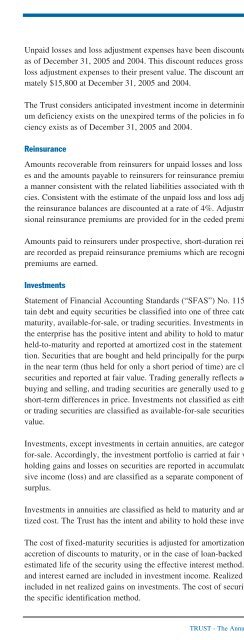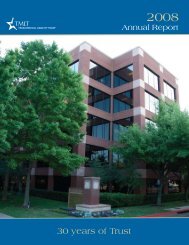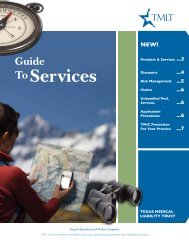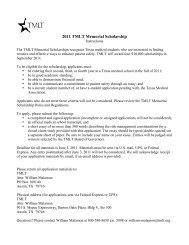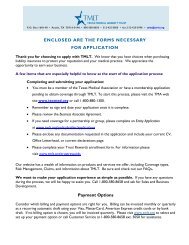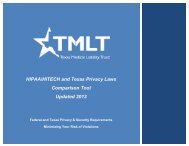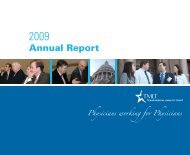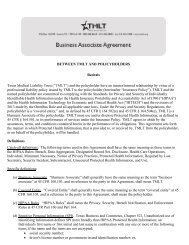Trust - TMLT
Trust - TMLT
Trust - TMLT
Create successful ePaper yourself
Turn your PDF publications into a flip-book with our unique Google optimized e-Paper software.
Unpaid losses and loss adjustment expenses have been discounted using a 6% factoras of December 31, 2005 and 2004. This discount reduces gross unpaid losses andloss adjustment expenses to their present value. The discount amount was approximately$15,800 at December 31, 2005 and 2004.Summary of SignificantAccounting PoliciesThe <strong>Trust</strong> considers anticipated investment income in determining whether a premiumdeficiency exists on the unexpired terms of the policies in force. No such deficiencyexists as of December 31, 2005 and 2004.ReinsuranceAmounts recoverable from reinsurers for unpaid losses and loss adjustment expensesand the amounts payable to reinsurers for reinsurance premiums are estimated ina manner consistent with the related liabilities associated with the reinsured policies.Consistent with the estimate of the unpaid loss and loss adjustment expenses,the reinsurance balances are discounted at a rate of 4%. Adjustments to the provisionalreinsurance premiums are provided for in the ceded premiums.Amounts paid to reinsurers under prospective, short-duration reinsurance contractsare recorded as prepaid reinsurance premiums which are recognized as the relatedpremiums are earned.InvestmentsStatement of Financial Accounting Standards (“SFAS”) No. 115 requires that certaindebt and equity securities be classified into one of three categories: held-tomaturity,available-for-sale, or trading securities. Investments in debt securities thatthe enterprise has the positive intent and ability to hold to maturity are classified asheld-to-maturity and reported at amortized cost in the statement of financial position.Securities that are bought and held principally for the purpose of selling themin the near term (thus held for only a short period of time) are classified as tradingsecurities and reported at fair value. Trading generally reflects active and frequentbuying and selling, and trading securities are generally used to generate profit onshort-term differences in price. Investments not classified as either held-to-maturityor trading securities are classified as available-for-sale securities and reported at fairvalue.Investments, except investments in certain annuities, are categorized as availablefor-sale.Accordingly, the investment portfolio is carried at fair value. Unrealizedholding gains and losses on securities are reported in accumulated other comprehensiveincome (loss) and are classified as a separate component of policyholders’surplus.Investments in annuities are classified as held to maturity and are carried at amortizedcost. The <strong>Trust</strong> has the intent and ability to hold these investments to maturity.The cost of fixed-maturity securities is adjusted for amortization of premiums andaccretion of discounts to maturity, or in the case of loan-backed securities, over theestimated life of the security using the effective interest method. Such amortizationand interest earned are included in investment income. Realized gains and losses areincluded in net realized gains on investments. The cost of securities sold is based onthe specific identification method.TRUST - The Annual Report Magazine31


